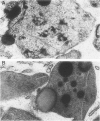Abstract
Biologic, morphologic, and biochemical investigations performed in 2 patients demonstrate multiple peroxisomal deficiencies in the cerebrohepatorenal syndrome of Zellweger (CHRS) and neonatal adrenoleukodystrophy (NALD). Very long chain fatty acids, abnormal bile acids, including bile acid precursors (di- and trihydroxycoprostanoic acids), and C29-dicarboxylic acid accumulated in plasma in both patients. Generalized hyperaminoaciduria was also present. Peroxisomes could not be detected in CHRS liver and kidney; however, in the NALD patient, small and sparse cytoplasmic bodies resembling altered peroxisomes were found in hepatocytes. Hepatocellular and Kupffer cell lysosomes were engorged with ferritin and contained clefts and trilaminar structures believed to represent very long chain fatty acids. Enzymatic deficiencies reflected the peroxisomal defects. Hepatic glycolate oxidase and palmitoyl-CoA oxidase activities were deficient. No particle-bound catalase was found in cultured fibroblasts, and ether glycerolipid (plasmalogen) biosynthesis was markedly reduced. Administration of phenobarbital and clofibrate, an agent that induces peroxisomal proliferation and enzymatic activities, to the NALD patient did not bring about any changes in plasma metabolites, liver peroxisome population, or oxidizing activities.
Full text
PDF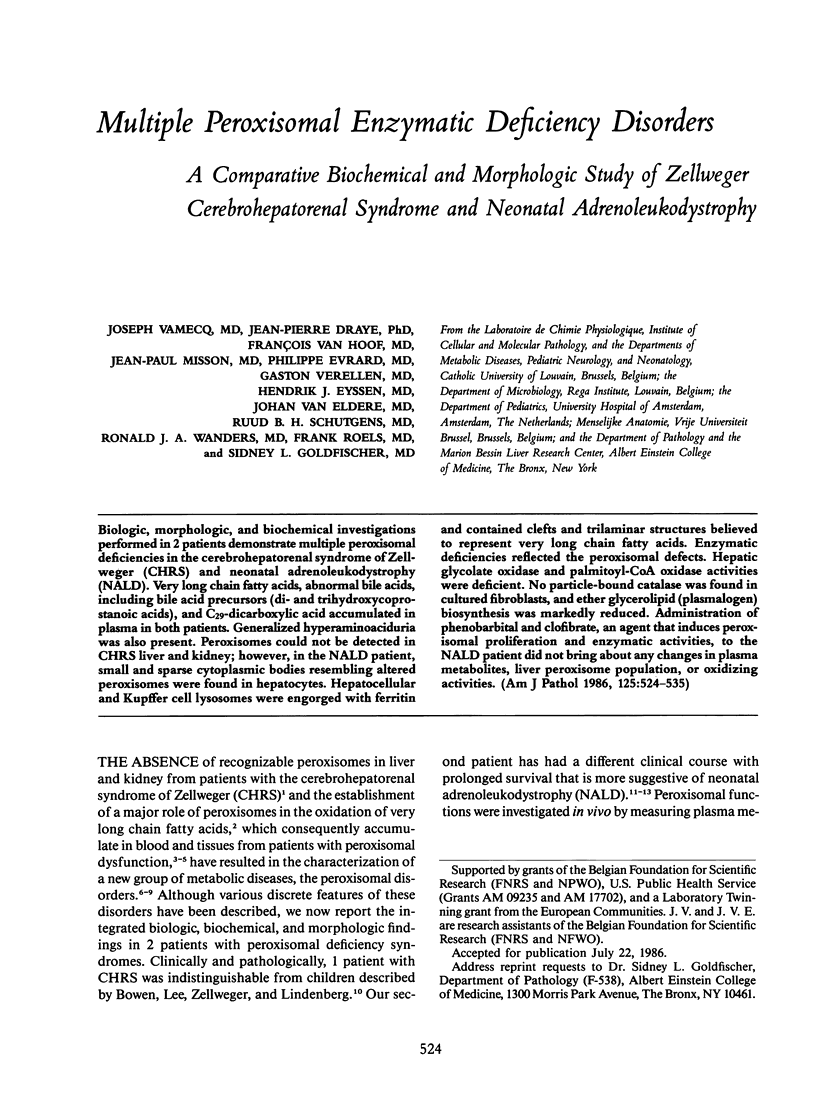
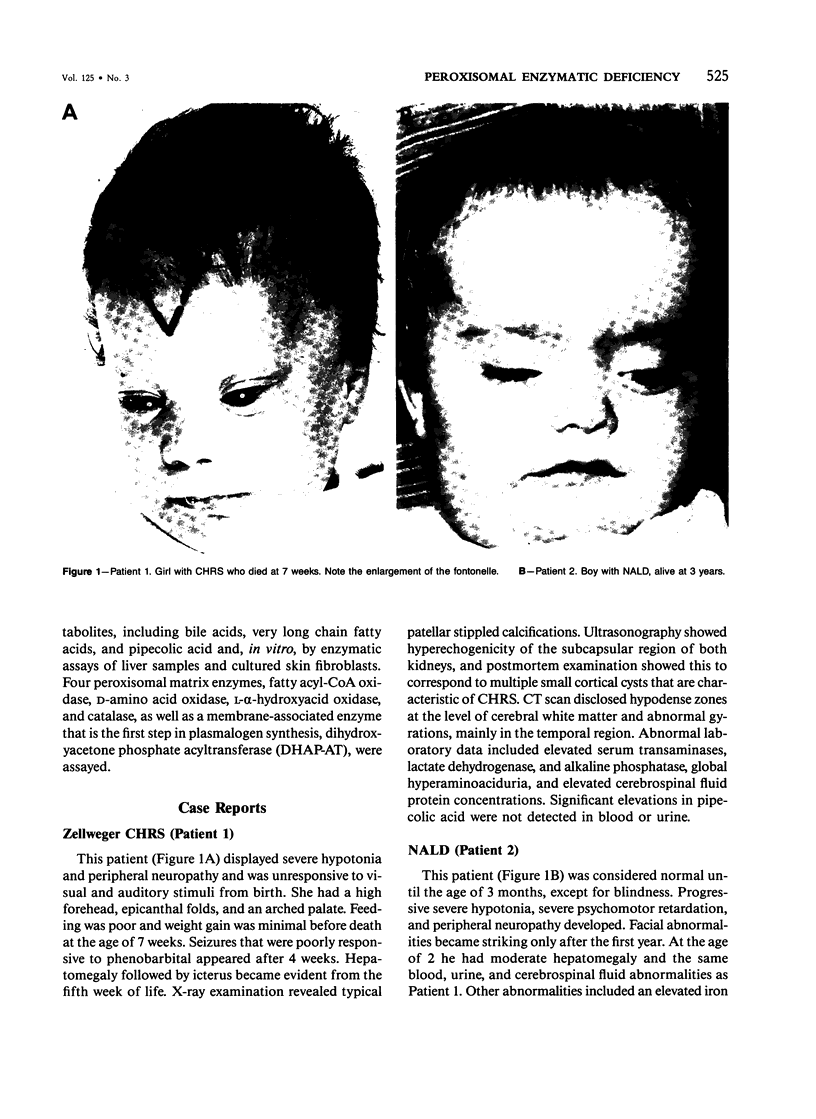
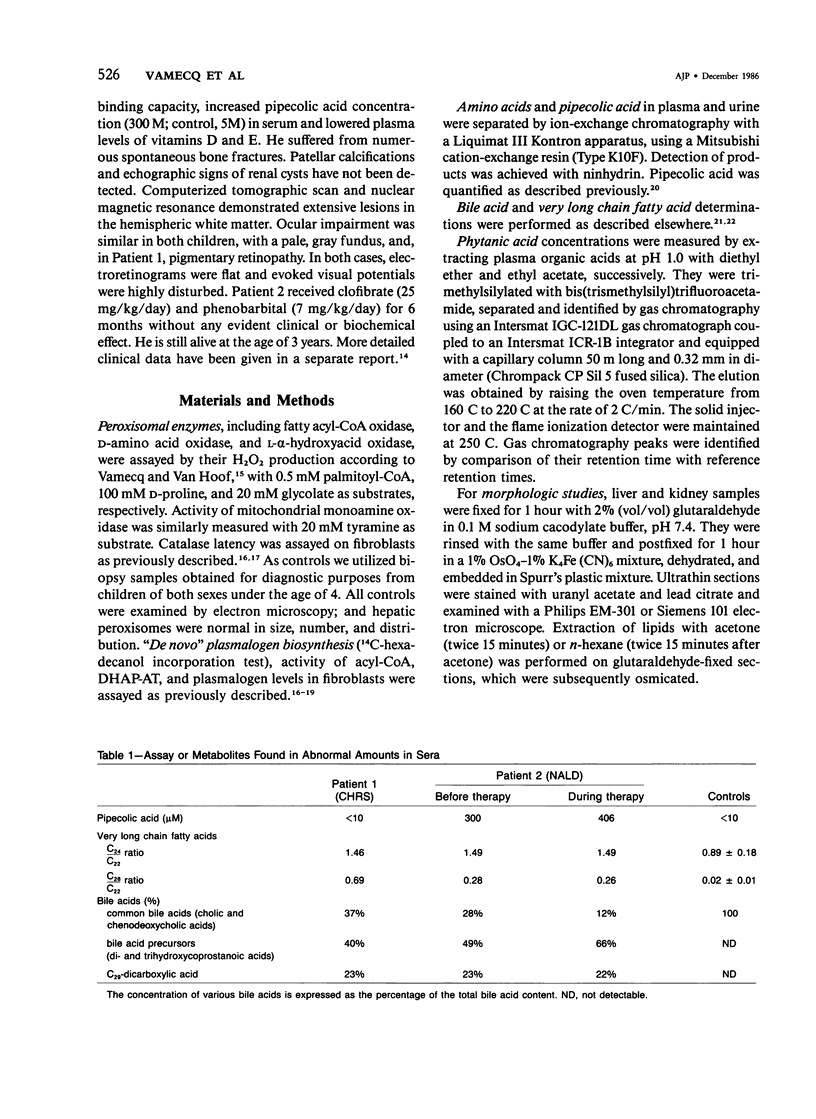
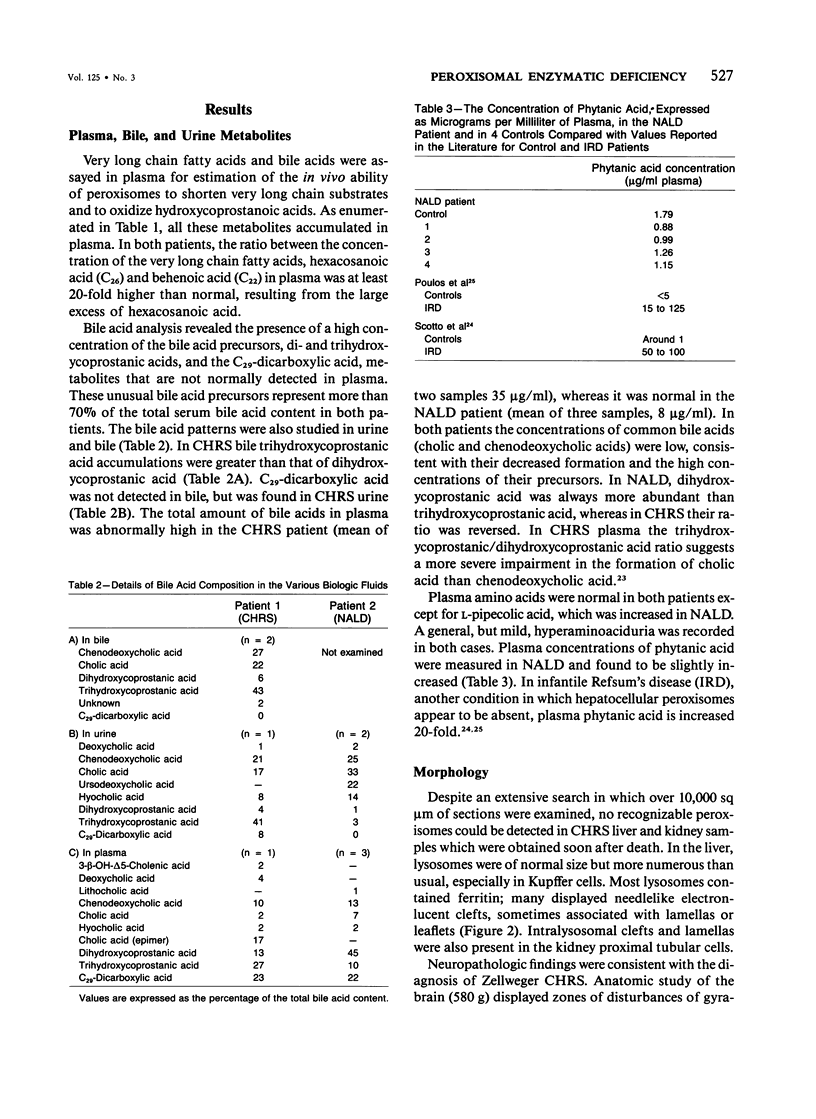
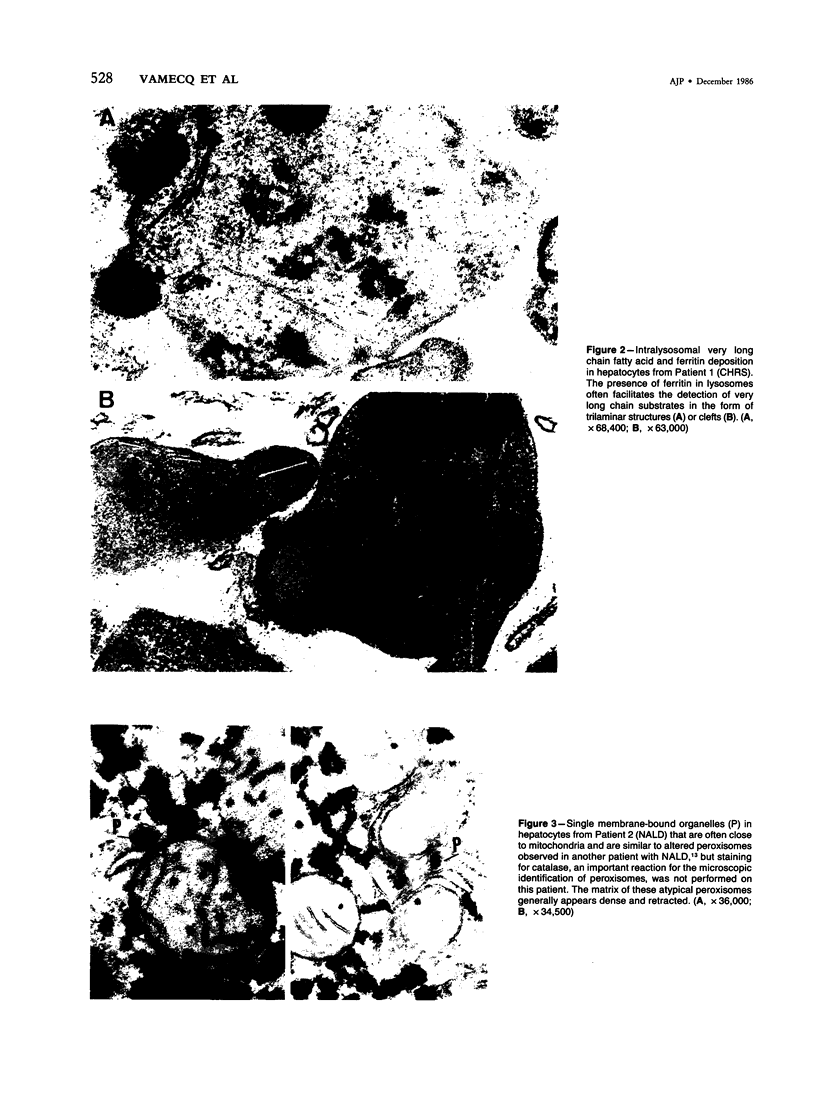
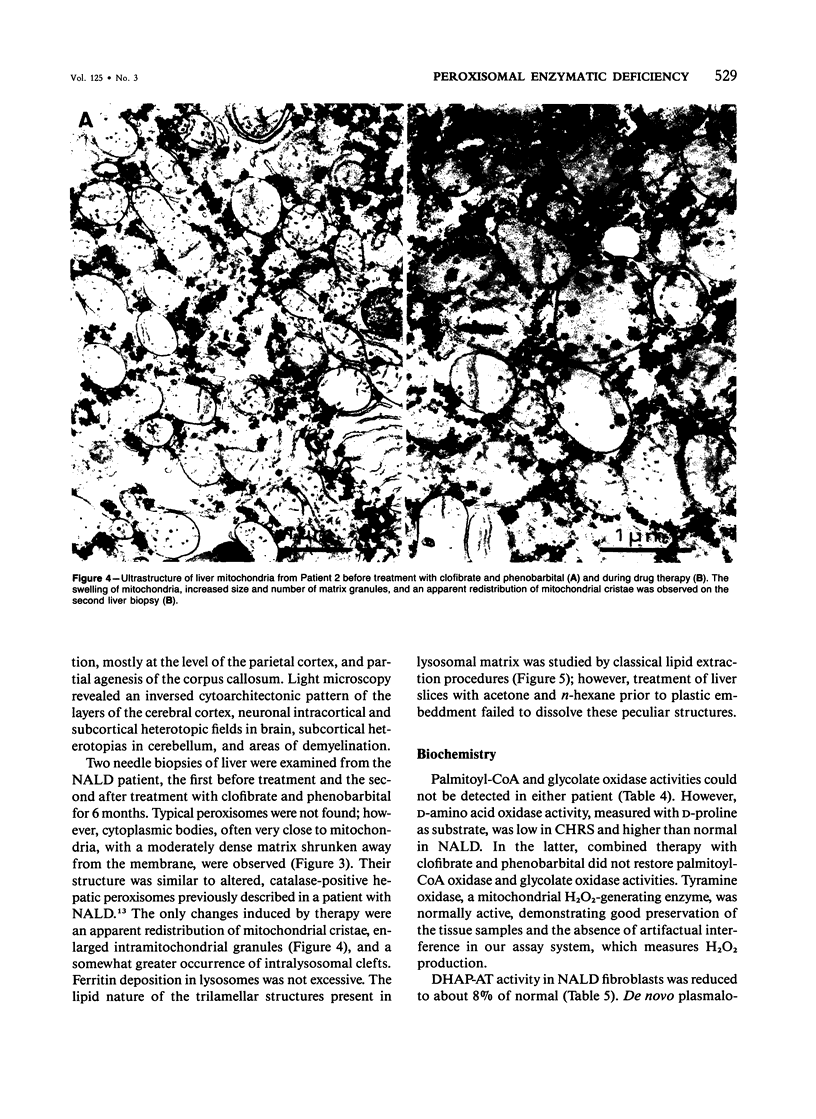
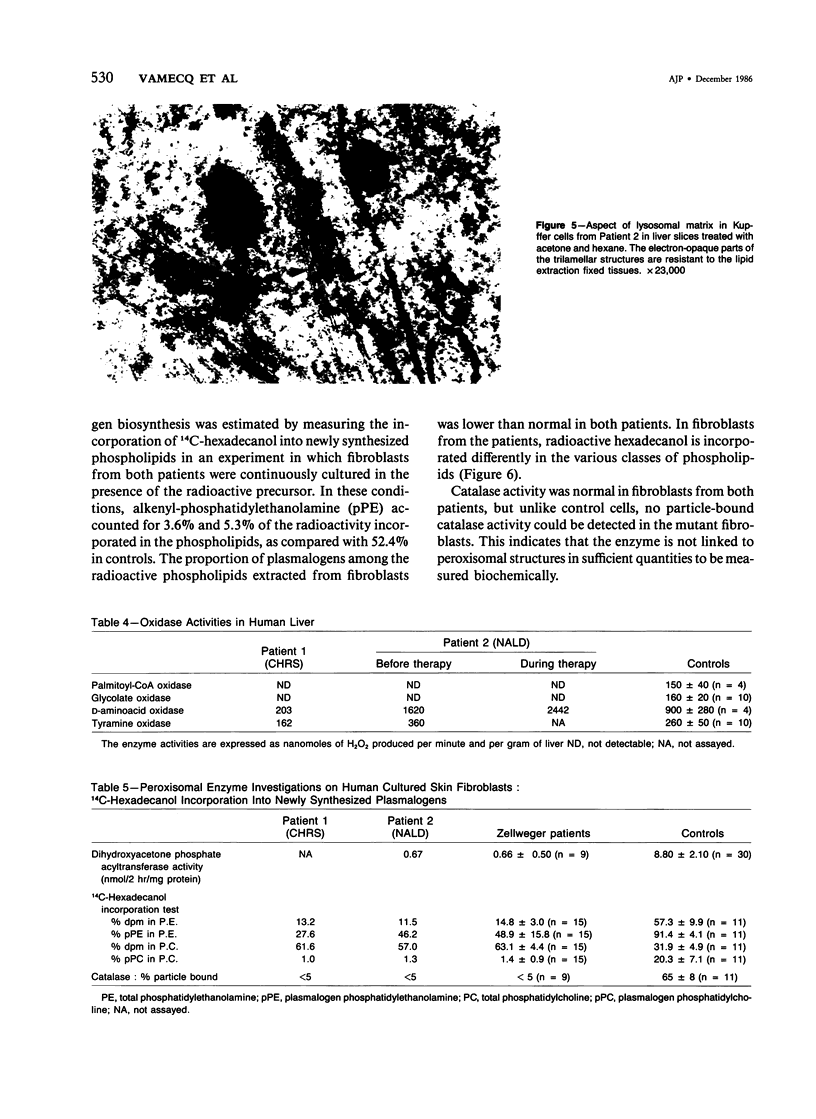
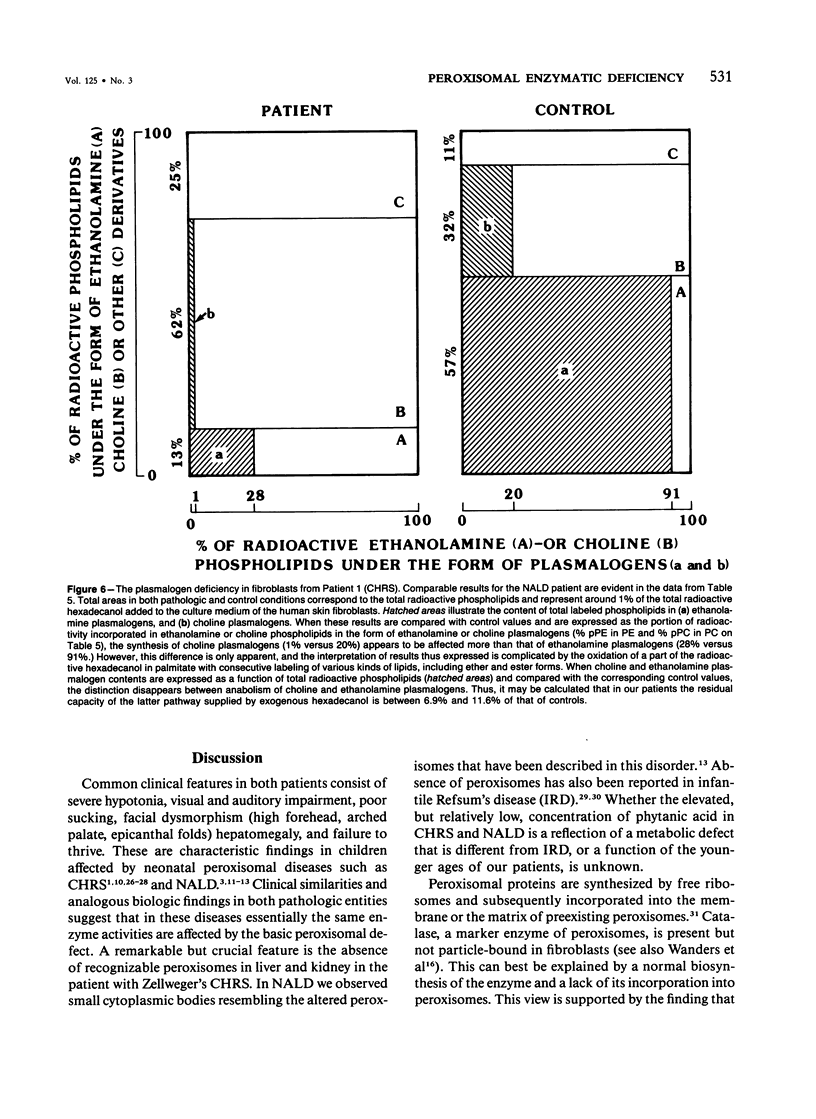
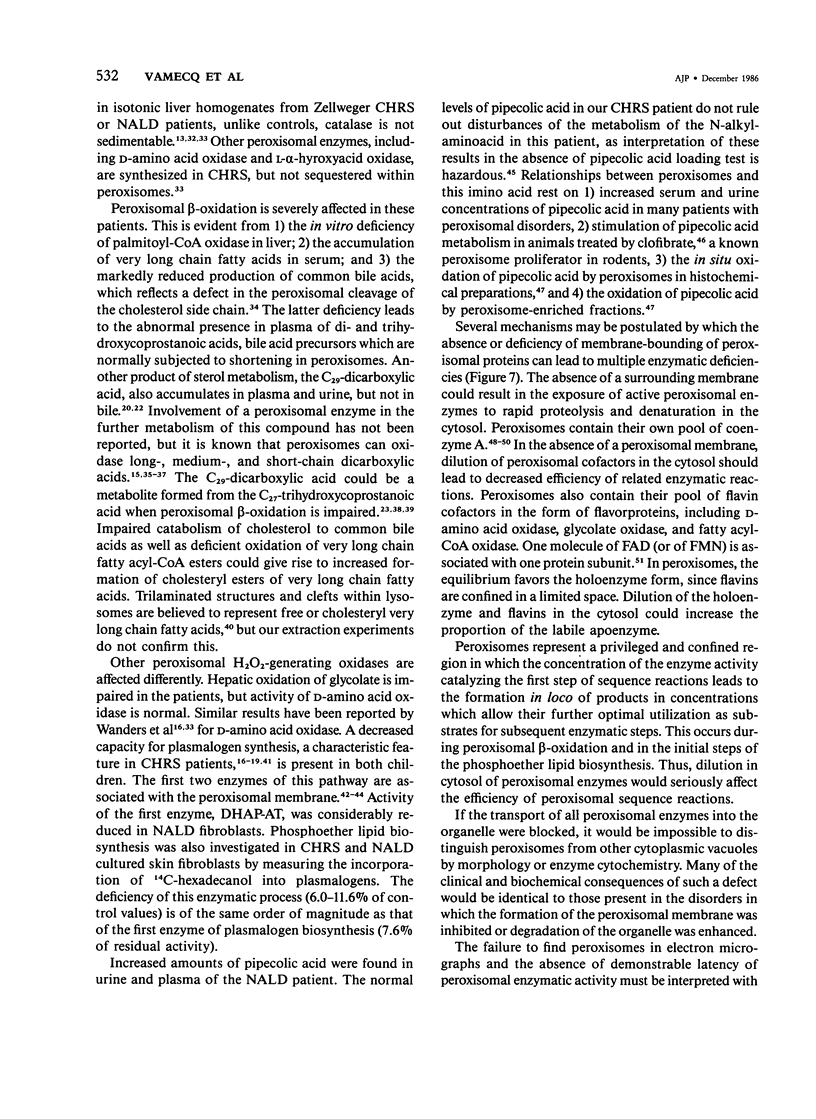
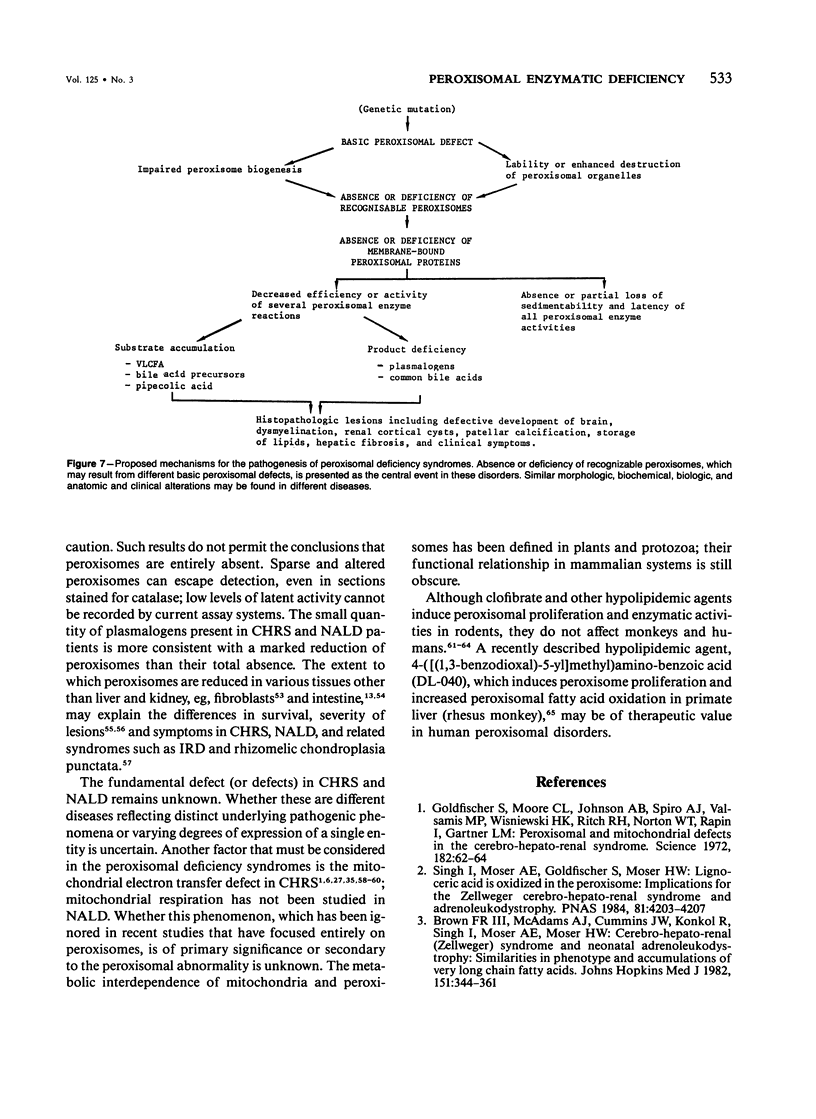
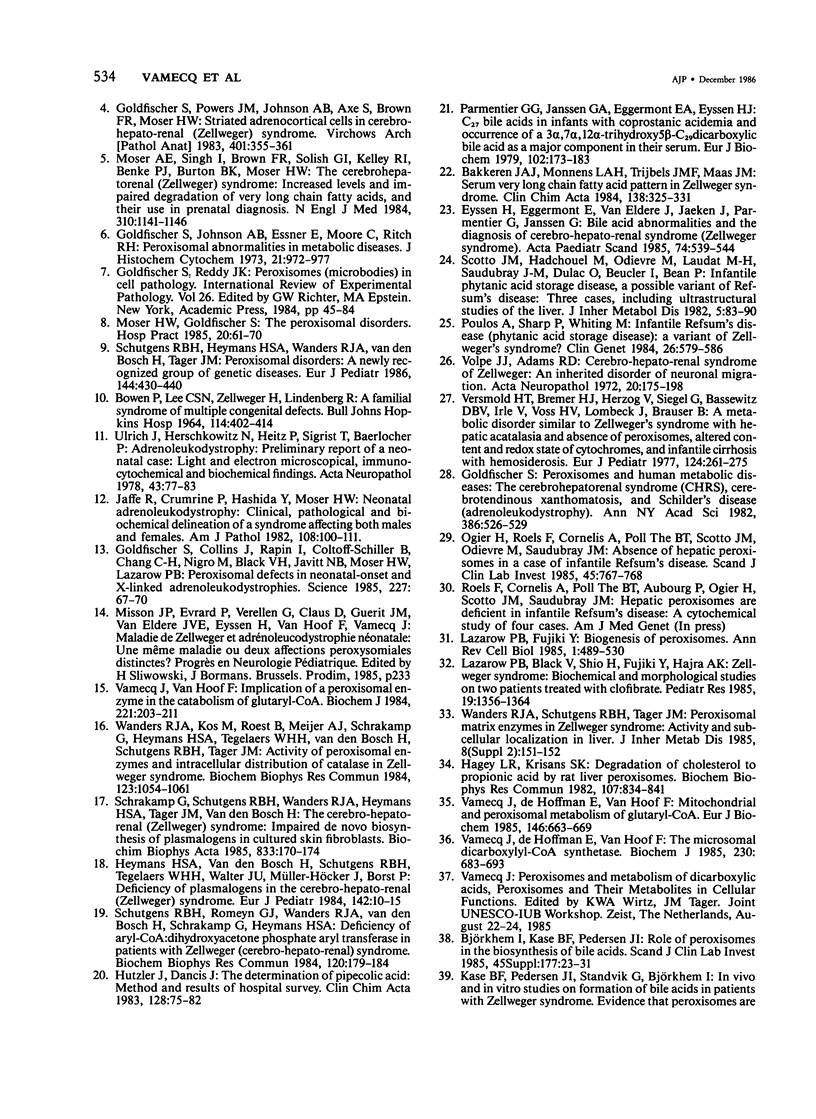
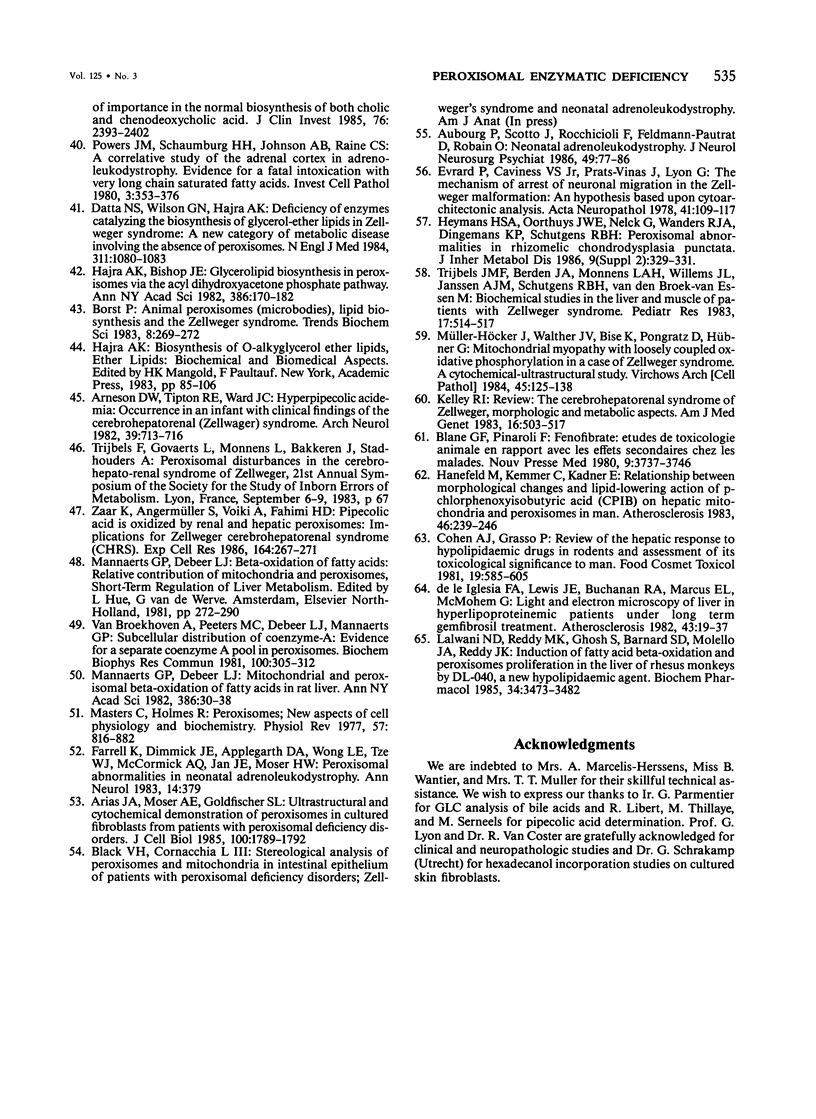
Images in this article
Selected References
These references are in PubMed. This may not be the complete list of references from this article.
- Arias J. A., Moser A. B., Goldfischer S. L. Ultrastructural and cytochemical demonstration of peroxisomes in cultured fibroblasts from patients with peroxisomal deficiency disorders. J Cell Biol. 1985 May;100(5):1789–1792. doi: 10.1083/jcb.100.5.1789. [DOI] [PMC free article] [PubMed] [Google Scholar]
- Arneson D. W., Tipton R. E., Ward J. C. Hyperpipecolic acidemia. Occurrence in an infant with clinical findings of the cerebrohepatorenal (Zellweger) syndrome. Arch Neurol. 1982 Nov;39(11):713–716. doi: 10.1001/archneur.1982.00510230039011. [DOI] [PubMed] [Google Scholar]
- Aubourg P., Scotto J., Rocchiccioli F., Feldmann-Pautrat D., Robain O. Neonatal adrenoleukodystrophy. J Neurol Neurosurg Psychiatry. 1986 Jan;49(1):77–86. doi: 10.1136/jnnp.49.1.77. [DOI] [PMC free article] [PubMed] [Google Scholar]
- BOWEN P., LEE C. S., ZELLWEGER H., LINDENBERG R. A FAMILIAL SYNDROME OF MULTIPLE CONGENITAL DEFECTS. Bull Johns Hopkins Hosp. 1964 Jun;114:402–414. [PubMed] [Google Scholar]
- Bakkeren J. A., Monnens L. A., Trijbels J. M., Maas J. M. Serum very long chain fatty acid pattern in Zellweger syndrome. Clin Chim Acta. 1984 Apr 27;138(3):325–331. doi: 10.1016/0009-8981(84)90140-2. [DOI] [PubMed] [Google Scholar]
- Björkhem I., Kase B. F., Pedersen J. I. Role of peroxisomes in the biosynthesis of bile acids. Scand J Clin Lab Invest Suppl. 1985;177:23–31. [PubMed] [Google Scholar]
- Blane G. F., Pinaroli F. Fénofibrate: études de toxicologie animale en rapport avec les effets secondaires chez les malades. Nouv Presse Med. 1980 Dec 22;9(49):3737–3746. [PubMed] [Google Scholar]
- Brown F. R., 3rd, McAdams A. J., Cummins J. W., Konkol R., Singh I., Moser A. B., Moser H. W. Cerebro-hepato-renal (Zellweger) syndrome and neonatal adrenoleukodystrophy: similarities in phenotype and accumulation of very long chain fatty acids. Johns Hopkins Med J. 1982 Dec;151(6):344–351. [PubMed] [Google Scholar]
- Cohen A. J., Grasso P. Review of the hepatic response to hypolipidaemic drugs in rodents and assessment of its toxicological significance to man. Food Cosmet Toxicol. 1981 Oct;19(5):585–605. doi: 10.1016/0015-6264(81)90509-5. [DOI] [PubMed] [Google Scholar]
- Datta N. S., Wilson G. N., Hajra A. K. Deficiency of enzymes catalyzing the biosynthesis of glycerol-ether lipids in Zellweger syndrome. A new category of metabolic disease involving the absence of peroxisomes. N Engl J Med. 1984 Oct 25;311(17):1080–1083. doi: 10.1056/NEJM198410253111704. [DOI] [PubMed] [Google Scholar]
- De La Iglesia F. A., Lewis J. E., Buchanan R. A., Marcus E. L., McMahon G. Light and electron microscopy of liver in hyperlipoproteinemic patients under long-term gemfibrozil treatment. Atherosclerosis. 1982 May;43(1):19–37. doi: 10.1016/0021-9150(82)90096-x. [DOI] [PubMed] [Google Scholar]
- Evrard P., Caviness V. S., Jr, Prats-Vinas J., Lyon G. The mechanism of arrest of neuronal migration in the Zellweger malformation: an hypothesis bases upon cytoarchitectonic analysis. Acta Neuropathol. 1978 Feb 20;41(2):109–117. doi: 10.1007/BF00689761. [DOI] [PubMed] [Google Scholar]
- Eyssen H., Eggermont E., van Eldere J., Jaeken J., Parmentier G., Janssen G. Bile acid abnormalities and the diagnosis of cerebro-hepato-renal syndrome (Zellweger syndrome). Acta Paediatr Scand. 1985 Jul;74(4):539–544. doi: 10.1111/j.1651-2227.1985.tb11025.x. [DOI] [PubMed] [Google Scholar]
- Goldfischer S., Collins J., Rapin I., Coltoff-Schiller B., Chang C. H., Nigro M., Black V. H., Javitt N. B., Moser H. W., Lazarow P. B. Peroxisomal defects in neonatal-onset and X-linked adrenoleukodystrophies. Science. 1985 Jan 4;227(4682):67–70. doi: 10.1126/science.3964959. [DOI] [PubMed] [Google Scholar]
- Goldfischer S., Johnson A. B., Essner E., Moore C., Ritch R. H. Peroxisomal abnormalities in metabolic diseases. J Histochem Cytochem. 1973 Nov;21(11):972–977. doi: 10.1177/21.11.972. [DOI] [PubMed] [Google Scholar]
- Goldfischer S., Moore C. L., Johnson A. B., Spiro A. J., Valsamis M. P., Wisniewski H. K., Ritch R. H., Norton W. T., Rapin I., Gartner L. M. Peroxisomal and mitochondrial defects in the cerebro-hepato-renal syndrome. Science. 1973 Oct 5;182(4107):62–64. doi: 10.1126/science.182.4107.62. [DOI] [PubMed] [Google Scholar]
- Goldfischer S., Powers J. M., Johnson A. B., Axe S., Brown F. R., Moser H. W. Striated adrenocortical cells in cerebro-hepato-renal (Zellweger) syndrome. Virchows Arch A Pathol Anat Histopathol. 1983;401(3):355–361. doi: 10.1007/BF00734851. [DOI] [PubMed] [Google Scholar]
- Goldfischer S., Reddy J. K. Peroxisomes (microbodies) in cell pathology. Int Rev Exp Pathol. 1984;26:45–84. [PubMed] [Google Scholar]
- Hagey L. R., Krisans S. K. Degradation of cholesterol to propionic acid by rat liver peroxisomes. Biochem Biophys Res Commun. 1982 Aug;107(3):834–841. doi: 10.1016/0006-291x(82)90598-8. [DOI] [PubMed] [Google Scholar]
- Hajra A. K., Bishop J. E. Glycerolipid biosynthesis in peroxisomes via the acyl dihydroxyacetone phosphate pathway. Ann N Y Acad Sci. 1982;386:170–182. doi: 10.1111/j.1749-6632.1982.tb21415.x. [DOI] [PubMed] [Google Scholar]
- Hanefeld M., Kemmer C., Kadner E. Relationship between morphological changes and lipid-lowering action of p-chlorphenoxyisobutyric acid (CPIB) on hepatic mitochondria and peroxisomes in man. Atherosclerosis. 1983 Feb;46(2):239–246. doi: 10.1016/0021-9150(83)90115-6. [DOI] [PubMed] [Google Scholar]
- Heymans H. S., vd Bosch H., Schutgens R. B., Tegelaers W. H., Walther J. U., Müller-Höcker J., Borst P. Deficiency of plasmalogens in the cerebro-hepato-renal (Zellweger) syndrome. Eur J Pediatr. 1984 Apr;142(1):10–15. doi: 10.1007/BF00442582. [DOI] [PubMed] [Google Scholar]
- Hutzler J., Dancis J. The determination of pipecolic acid: method and results of hospital survey. Clin Chim Acta. 1983 Feb 28;128(1):75–82. doi: 10.1016/0009-8981(83)90057-8. [DOI] [PubMed] [Google Scholar]
- Jaffe R., Crumrine P., Hashida Y., Moser H. W. Neonatal adrenoleukodystrophy: clinical, pathologic, and biochemical delineation of a syndrome affecting both males and females. Am J Pathol. 1982 Jul;108(1):100–111. [PMC free article] [PubMed] [Google Scholar]
- Kase B. F., Pedersen J. I., Strandvik B., Björkhem I. In vivo and vitro studies on formation of bile acids in patients with Zellweger syndrome. Evidence that peroxisomes are of importance in the normal biosynthesis of both cholic and chenodeoxycholic acid. J Clin Invest. 1985 Dec;76(6):2393–2402. doi: 10.1172/JCI112252. [DOI] [PMC free article] [PubMed] [Google Scholar]
- Kelley R. I. Review: the cerebrohepatorenal syndrome of Zellweger, morphologic and metabolic aspects. Am J Med Genet. 1983 Dec;16(4):503–517. doi: 10.1002/ajmg.1320160409. [DOI] [PubMed] [Google Scholar]
- Lalwani N. D., Reddy M. K., Ghosh S., Barnard S. D., Molello J. A., Reddy J. K. Induction of fatty acid beta-oxidation and peroxisome proliferation in the liver of rhesus monkeys by DL-040, a new hypolipidemic agent. Biochem Pharmacol. 1985 Oct 1;34(19):3473–3482. doi: 10.1016/0006-2952(85)90720-8. [DOI] [PubMed] [Google Scholar]
- Lazarow P. B., Black V., Shio H., Fujiki Y., Hajra A. K., Datta N. S., Bangaru B. S., Dancis J. Zellweger syndrome: biochemical and morphological studies on two patients treated with clofibrate. Pediatr Res. 1985 Dec;19(12):1356–1364. doi: 10.1203/00006450-198512000-00030. [DOI] [PubMed] [Google Scholar]
- Lazarow P. B., Fujiki Y. Biogenesis of peroxisomes. Annu Rev Cell Biol. 1985;1:489–530. doi: 10.1146/annurev.cb.01.110185.002421. [DOI] [PubMed] [Google Scholar]
- Mannaerts G. P., Debeer L. J. Mitochondrial and peroxisomal beta-oxidation of fatty acids in rat liver. Ann N Y Acad Sci. 1982;386:30–39. doi: 10.1111/j.1749-6632.1982.tb21405.x. [DOI] [PubMed] [Google Scholar]
- Masters C., Holmes R. Peroxisomes: new aspects of cell physiology and biochemistry. Physiol Rev. 1977 Oct;57(4):816–882. doi: 10.1152/physrev.1977.57.4.816. [DOI] [PubMed] [Google Scholar]
- Moser A. E., Singh I., Brown F. R., 3rd, Solish G. I., Kelley R. I., Benke P. J., Moser H. W. The cerebrohepatorenal (Zellweger) syndrome. Increased levels and impaired degradation of very-long-chain fatty acids and their use in prenatal diagnosis. N Engl J Med. 1984 May 3;310(18):1141–1146. doi: 10.1056/NEJM198405033101802. [DOI] [PubMed] [Google Scholar]
- Moser H. W., Goldfischer S. L. The peroxisomal disorders. Hosp Pract (Off Ed) 1985 Sep 15;20(9):61–70. doi: 10.1080/21548331.1985.11703129. [DOI] [PubMed] [Google Scholar]
- Müller-Höcker J., Walther J. U., Bise K., Pongratz D., Hübner G. Mitochondrial myopathy with loosely coupled oxidative phosphorylation in a case of Zellweger syndrome. A cytochemical-ultrastructural study. Virchows Arch B Cell Pathol Incl Mol Pathol. 1984;45(2):125–138. doi: 10.1007/BF02889859. [DOI] [PubMed] [Google Scholar]
- Ogier H., Roels F., Cornelis A., Poll The B. T., Scotto J. M., Odievre M., Sandubray J. M. Absence of hepatic peroxisomes in a case of infantile Refsum's disease. Scand J Clin Lab Invest. 1985 Dec;45(8):767–768. doi: 10.3109/00365518509155292. [DOI] [PubMed] [Google Scholar]
- Parmentier G. G., Janssen G. A., Eggermont E. A., Eyssen H. J. C27 bile acids in infants with coprostanic acidemia and occurrence of a 3 alpha,7 alpha,12 alpha-tridhydroxy-5 beta-C29 dicarboxylic bile acid as a major component in their serum. Eur J Biochem. 1979 Dec;102(1):173–183. doi: 10.1111/j.1432-1033.1979.tb06278.x. [DOI] [PubMed] [Google Scholar]
- Poulos A., Sharp P., Whiting M. Infantile Refsum's disease (phytanic acid storage disease): a variant of Zellweger's syndrome? Clin Genet. 1984 Dec;26(6):579–586. doi: 10.1111/j.1399-0004.1984.tb01107.x. [DOI] [PubMed] [Google Scholar]
- Powers J. M., Schaumburg H. H., Johnson A. B., Raine C. S. A correlative study of the adrenal cortex in adreno-leukodystrophy--evidence for a fatal intoxication with very long chain saturated fatty acids. Invest Cell Pathol. 1980 Oct-Dec;3(4):353–376. [PubMed] [Google Scholar]
- Schrakamp G., Schutgens R. B., Wanders R. J., Heymans H. S., Tager J. M., Van den Bosch H. The cerebro-hepato-renal (Zellweger) syndrome. Impaired de novo biosynthesis of plasmalogens in cultured skin fibroblasts. Biochim Biophys Acta. 1985 Jan 9;833(1):170–174. doi: 10.1016/0005-2760(85)90266-8. [DOI] [PubMed] [Google Scholar]
- Schutgens R. B., Heymans H. S., Wanders R. J., van den Bosch H., Tager J. M. Peroxisomal disorders: a newly recognised group of genetic diseases. Eur J Pediatr. 1986 Feb;144(5):430–440. doi: 10.1007/BF00441734. [DOI] [PubMed] [Google Scholar]
- Schutgens R. B., Romeyn G. J., Wanders R. J., van den Bosch H., Schrakamp G., Heymans H. S. Deficiency of acyl-CoA: dihydroxyacetone phosphate acyltransferase in patients with Zellweger (cerebro-hepato-renal) syndrome. Biochem Biophys Res Commun. 1984 Apr 16;120(1):179–184. doi: 10.1016/0006-291x(84)91430-x. [DOI] [PubMed] [Google Scholar]
- Scotto J. M., Hadchouel M., Odievre M., Laudat M. H., Saudubray J. M., Dulac O., Beucler I., Beaune P. Infantile phytanic acid storage disease, a possible variant of Refsum's disease: three cases, including ultrastructural studies of the liver. J Inherit Metab Dis. 1982;5(2):83–90. doi: 10.1007/BF01799998. [DOI] [PubMed] [Google Scholar]
- Singh I., Moser A. E., Goldfischer S., Moser H. W. Lignoceric acid is oxidized in the peroxisome: implications for the Zellweger cerebro-hepato-renal syndrome and adrenoleukodystrophy. Proc Natl Acad Sci U S A. 1984 Jul;81(13):4203–4207. doi: 10.1073/pnas.81.13.4203. [DOI] [PMC free article] [PubMed] [Google Scholar]
- Trijbels J. M., Berden J. A., Monnens L. A., Willems J. L., Janssen A. J., Schutgens R. B., van den Broek-Van Essen M. Biochemical studies in the liver and muscle of patients with Zellweger syndrome. Pediatr Res. 1983 Jun;17(6):514–517. doi: 10.1203/00006450-198306000-00018. [DOI] [PubMed] [Google Scholar]
- Ulrich J., Herschkowitz N., Heitz P., Sigrist T., Baerlocher P. Adrenoleukodystrophy. Preliminary report of a connatal case. Light- and electron microscopical, immunohistochemical and biochemical findings. Acta Neuropathol. 1978 Aug 7;43(1-2):77–83. doi: 10.1007/BF00685001. [DOI] [PubMed] [Google Scholar]
- Vamecq J., Van Hoof F. Implication of a peroxisomal enzyme in the catabolism of glutaryl-CoA. Biochem J. 1984 Jul 1;221(1):203–211. doi: 10.1042/bj2210203. [DOI] [PMC free article] [PubMed] [Google Scholar]
- Vamecq J., de Hoffmann E., Van Hoof F. Mitochondrial and peroxisomal metabolism of glutaryl-CoA. Eur J Biochem. 1985 Feb 1;146(3):663–669. doi: 10.1111/j.1432-1033.1985.tb08702.x. [DOI] [PubMed] [Google Scholar]
- Vamecq J., de Hoffmann E., Van Hoof F. The microsomal dicarboxylyl-CoA synthetase. Biochem J. 1985 Sep 15;230(3):683–693. doi: 10.1042/bj2300683. [DOI] [PMC free article] [PubMed] [Google Scholar]
- Van Broekhoven A., Peeters M. C., Debeer L. J., Mannaerts G. P. Subcellular distribution of coenzyme A: evidence for a separate coenzyme A pool in peroxisomes. Biochem Biophys Res Commun. 1981 May 15;100(1):305–312. doi: 10.1016/s0006-291x(81)80097-6. [DOI] [PubMed] [Google Scholar]
- Versmold H. T., Bremer H. J., Herzog V., Siegel G., Bassewitz D. B., Irle U., Voss H., Lombeck I., Brauser B. A metabolic disorder similar to Zellweger syndrome with hepatic acatalasia and absence of peroxisomes, altered content and redox state of cytochromes, and infantile cirrhosis with hemosiderosis. Eur J Pediatr. 1977 Mar 18;124(4):261–275. doi: 10.1007/BF00441934. [DOI] [PubMed] [Google Scholar]
- Volpe J. J., Adams R. D. Cerebro-hepato-renal syndrome of Zellweger: an inherited disorder of neuronal migration. Acta Neuropathol. 1972;20(3):175–198. doi: 10.1007/BF00686900. [DOI] [PubMed] [Google Scholar]
- Wanders R. J., Kos M., Roest B., Meijer A. J., Schrakamp G., Heymans H. S., Tegelaers W. H., van den Bosch H., Schutgens R. B., Tager J. M. Activity of peroxisomal enzymes and intracellular distribution of catalase in Zellweger syndrome. Biochem Biophys Res Commun. 1984 Sep 28;123(3):1054–1061. doi: 10.1016/s0006-291x(84)80240-5. [DOI] [PubMed] [Google Scholar]
- Wanders R. J., Schutgens R. B., Tager J. M. Peroxisomal matrix enzymes in Zellweger syndrome: activity and subcellular localization in liver. J Inherit Metab Dis. 1985;8 (Suppl 2):151–152. doi: 10.1007/BF01811504. [DOI] [PubMed] [Google Scholar]
- Zaar K., Angermüller S., Völkl A., Fahimi H. D. Pipecolic acid is oxidized by renal and hepatic peroxisomes. Implications for Zellweger's cerebro-hepato-renal syndrome (CHRS). Exp Cell Res. 1986 May;164(1):267–271. doi: 10.1016/0014-4827(86)90475-1. [DOI] [PubMed] [Google Scholar]




